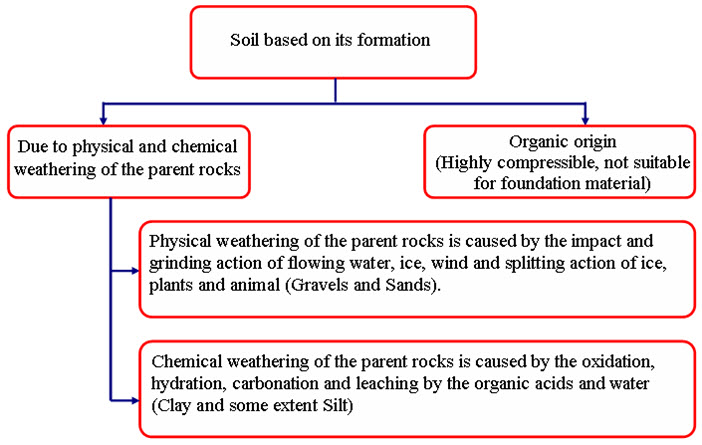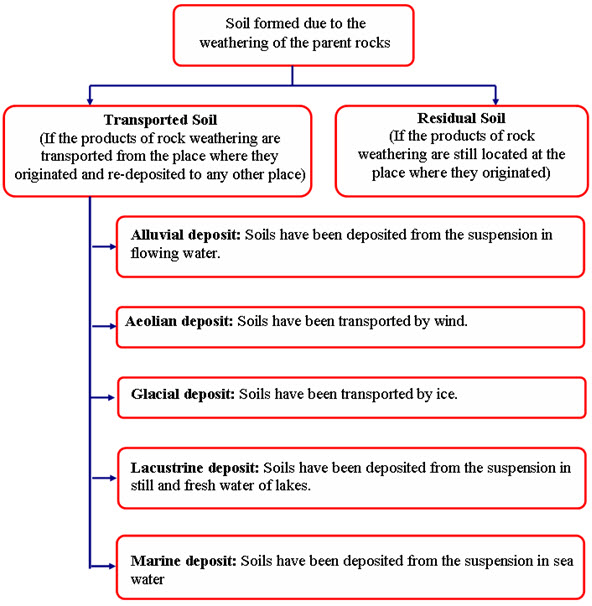Site pages
Current course
Participants
General
MODULE 1. Fundamentals of Soil Mechanics
MODULE 2. Stress and Strength
MODULE 3. Compaction, Seepage and Consolidation of...
MODULE 4. Earth pressure, Slope Stability and Soil...
Keywords
29 March - 4 April
5 April - 11 April
12 April - 18 April
19 April - 25 April
26 April - 2 May
LESSON 1. Introduction of Soil Mechanics
1.1 Soil and Soil mechanics
According to the Civil Engineering, the soil means all the naturally occurring, relatively unconsolidated organic or inorganic earth materials lie above the earth surface (Ranjan and Rao, 2000). The rocks are an agglomeration of mineral particles bonded together by strong molecular force. However, many hard soils can be termed as soft rock and vice versa. Rocks can be bed rocks or fragments of gravels, pebbles within the soil. The soil mechanics is the branch of Civil Engineering that uses the principles of mechanics, hydraulics and to some extent chemistry to solve the engineering problems related to soil. On the other hand, rock mechanics is a branch that applies the principles of mechanics to understand the behavior of rock masses.
1.2 Soil Formation
Based on the formation, soil can be divided into two groups: i) soils which are formed due to physical and chemical weathering of the parent rocks ii) soil which are of organic origin. The causes of the physical weathering of parent rocks are the impact and grinding action of flowing water, wind, ice and splitting action of ice, plants and animals. Gravel and sand are the soil those are formed due to physical weathering of parent rocks. The causes of the chemical weathering of the parent rocks are oxidation, hydration, carbonation and leaching by organic acids and water. Clay and some extent silt are the soils those are formed due to chemical weathering of parent rocks. Figure 1.1 shows the various types of soils based on their formation.
Figure 1.2 shows the various types of soils formed due to weathering of parent rocks. The soils those are formed due to the weathering of parent rocks can be divided into two groups: i) Transported soil and ii) Residual soil. The soil is called Transported soil if the products of rock weathering are transported from the place where they originated and re-deposited to any other place. The soil is called Residual soil if the products of rock weathering are still located at the place where they originated.
Depending upon the way of formation, the transported soil can be divided into five types: i) Alluvial deposit ii) Aeolian deposit iii) Glacial deposit iv) Lacustrine deposit v) Marine deposit. The Alluvial soils are deposited from the suspension of flowing water. The soils are called Aeolian if they have been transported by wind. If the soils have been transported by ice are called Glacial deposit. Lacustrine soils have been deposited from the suspension in still and fresh water of lakes. Marine soils have been deposited from the suspension in sea water.
1.3 Common Soils in India
The common Indian soils are presented below:
(i) Marine deposits: These soils are found along the coast in narrow tidal plains. These are very soft with low shear strength and high compressibility. Construction of structures on these soils is very challenging due to low bearing capacity and excessive settlement.
(ii) Laterites soils: These soils are found in Kerala, Karnataka, Maharashtra, Orissa, and West Bengal. These are formed due to the decomposition of rocks and reddish in color.
(iii) Black cotton soils: These are expansive soils found in Maharashtra, Gujarat, Madhya Pradesh, Karnataka, Tamil Nadu, Andhra Pradesh and Uttar Pradesh.
(iv) Alluvial soils: These are found in Assam to Punjab covering a large part of northern India. These soils have alternating layers of sand, silt and clay.
(v) Desert soils: These are found in large parts of Rajasthan.
(vi) Boulder deposits: These are found in the sub-Himalayan regions of Himachal Pradesh and Uttar Pradesh.

Figure 1.1: Various types of soils based on their formation.

Figure 1.2: Various types of soils formed due to weathering of parent rocks.
References
Ranjan, G. and Rao, A.S.R. (2000). Basic and Applied Soil Mechanics. New Age International Publisher, New Delhi, India
Suggested Readings
Ranjan, G. and Rao, A.S.R. (2000) Basic and Applied Soil Mechanics. New Age International Publisher, New Delhi, India.
Arora, K.R. (2003) Soil Mechanics and Foundation Engineering. Standard Publishers Distributors, New Delhi, India
Murthy V.N.S (1996) A Text Book of Soil Mechanics and Foundation Engineering, UBS Publishers’ Distributors Ltd. New Delhi, India.